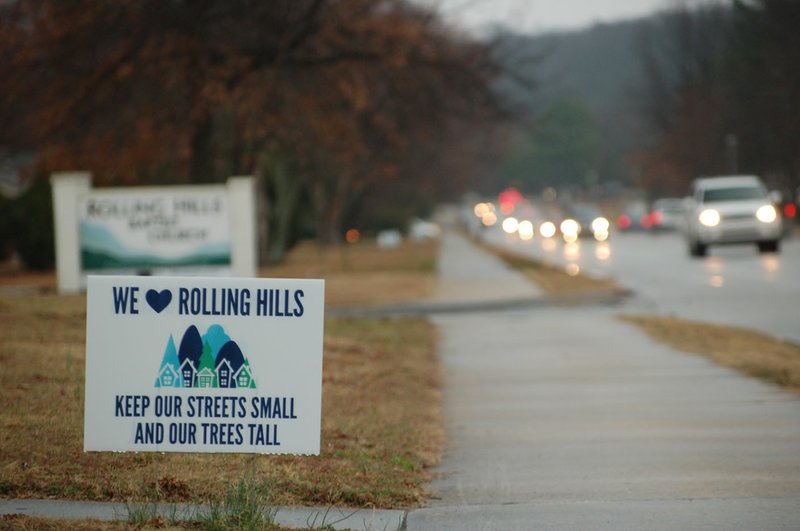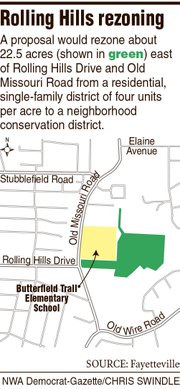FAYETTEVILLE -- Big-picture discussions about city planning and how to accommodate growth stemmed from the first reading Tuesday of an ordinance to rezone about 20 wooded acres on the northeast side of town.
Topics ranged from whether the rezoning at Rolling Hills Drive and Old Missouri Road would promote or decrease affordable housing, how more people moving into the neighborhood would affect schools and the ecology of the green space. The City Council made no decision and will take up the item again during its next meeting at 5:30 p.m. May 1.
Other items
The City Council also approved the following measures Tuesday:
• Vacating a portion of Nettleship Street so Leroy Pond Drive can pass through to Graham Avenue near Razorback Stadium.
• Changing city code to require approval of a development before any grading permits can be issued.
The council left on its second reading:
• Rezoning 56 acres at Rupple and Mount Comfort roads from a residential zone to a Community Services district, which will open the land up to a potential mixed use of commercial and residential development.
Source: Staff report
Ordinances normally require three readings before a council vote, unless a council member moves to suspend the rules and go onto the next reading. That typically happens with uncontroversial items.
The Rolling Hills rezoning gained a significant amount of attention since the Planning Commission first took it up around the beginning of the year. Dozens of residents consistently have shown up to voice concerns during public meetings. The proposal saw revisions after residents pointed out the application didn't address compatibility issues with surrounding land uses, as city code dictates.
Thirteen residents spoke Tuesday, all but one of whom was against rezoning. The proposal would change the area from a residential district allowing four units on an acre to a residential district allowing up to 10 units per acre. Lot sizes would be smaller, from 8,000 square feet to 4,000 square feet. The new neighborhood conservation district also allows duplexes and three- and four-family residential structures with a permit, whereas the current zoning only allows single family homes and duplexes. Tree preservation requirements on the new zoning also are slightly less stringent.
Mitch Weigel with Downtown Properties Real Estate Group, representing the landowner, said work started last summer to build a community in accordance with the city's long-term 2030 plan goals. Another 11-acre section of the total 50-acre plot was rezoned then to allow a mixed use of commercial and residential uses.
Weigel said he anticipated about 80 mostly single-family homes could go on the property. The intention is to put the land on the market for sale.
"There's an influx of desire to have a nice house on a smaller lot," he said.
Leigh Anne Yeargan said the effect the rezoning would have on public services, such as nearby Butterfield Trail Elementary School and water and sewer lines, is still unknown. She characterized the proposal as spot zoning and said overwhelming opposition from the neighborhood should serve as the primary reason to deny.
"We have been active. We have attended meetings," Yeargan said. "We are voicing our opinion."
Other residents brought up the possibility of a nonprofit working to preserve the acreage as an outdoor learning center. More asked about requesting a planned zoning district, which is essentially a rezoning request that addresses issues beyond land uses and population density.
Council member Matthew Petty asked the residents fundamental questions about why having more people in a neighborhood could be seen as a bad thing. He told audience members the council needs to know specifically why residents are against an aspect of the proposal, not just that they are against it.
In a separate item, the council pushed an amendment to the city's overall street plan down to the Transportation Committee, which consists of half the City Council.
The plan would downgrade the classification of Rolling Hills Drive from a main arterial to a collector street. The amendment also includes connecting Rolling Hills to Oak Bailey Drive, which would make a way to Crossover Road.
The Transportation Committee will focus mainly on more technical aspects of the proposal. The committee will meet after the council's agenda session, which begins 4:30 p.m. Tuesday.
NW News on 04/18/2018



